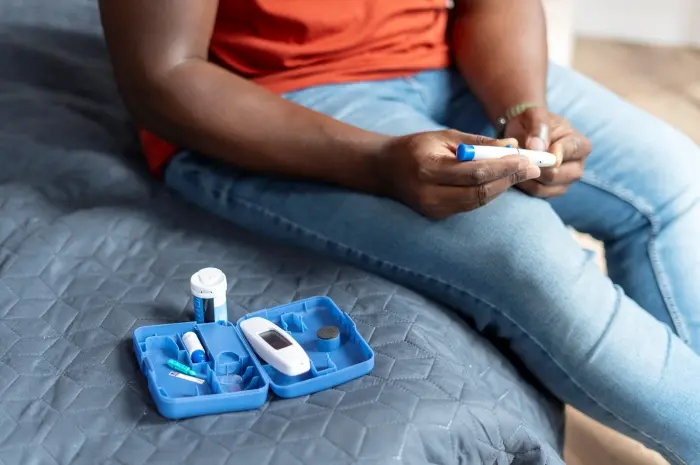Learn about the early indicators of diabetes, including frequent urination, fatigue, and slow wound healing, to ensure timely diagnosis and effective management.
Diabetes is a chronic condition affecting millions worldwide, characterized by elevated blood glucose levels due to either insufficient insulin production or the body’s inability to use insulin effectively.
The two most common types—Type 1 and Type 2 diabetes—can have serious long-term health consequences if not detected early and managed properly.
Recognizing the early signs of diabetes can lead to timely medical intervention, potentially preventing complications such as cardiovascular disease, nerve damage, and kidney failure.
In this article, we will explore the initial indicators of diabetes and why paying attention to these symptoms is crucial for overall health.
1. Frequent Urination (Polyuria)
One of the earliest and most common indicators of diabetes is frequent urination. Elevated blood sugar levels cause the kidneys to work harder to filter and absorb the excess glucose.
When the kidneys can’t keep up, the excess glucose is excreted through urine, dragging fluids from tissues and leading to increased urination, especially at night.
If you find yourself visiting the restroom far more frequently than usual, this could be an early warning sign of diabetes.
2. Excessive Thirst (Polydipsia)
Hand-in-hand with frequent urination comes excessive thirst. As the body loses more fluids through increased urination, it triggers a persistent feeling of thirst to compensate for dehydration.
This cycle can become relentless, with individuals feeling like they can never drink enough water. If your thirst seems unquenchable and is accompanied by frequent urination, it may be time to consult a healthcare professional.
3. Unexplained Weight Loss
Unexplained weight loss can be more common in Type 1 diabetes but may also appear in those with Type 2 diabetes. When your body isn’t able to use glucose for energy due to a lack of insulin or insulin resistance, it begins breaking down fat and muscle to compensate.
This process can result in sudden and significant weight loss, even if you’re eating regular meals. If you’re losing weight without making any changes to your diet or exercise routine, it’s essential to have your blood sugar levels checked.
4. Constant Hunger (Polyphagia)
Excessive hunger is another early sign of diabetes. When glucose isn’t effectively used as an energy source, your body feels starved and sends signals for more food, even if you’ve just eaten.
This symptom is often accompanied by fatigue and weight changes, making it a clear indicator that your body isn’t processing glucose correctly.
5. Fatigue and Weakness
Feeling consistently tired despite adequate sleep and rest is another potential sign of diabetes. When your body can’t use glucose for energy, it results in chronic fatigue and weakness.
Additionally, dehydration from frequent urination can compound feelings of tiredness. Persistent fatigue should not be dismissed, as it may indicate an underlying health issue.
6. Blurred Vision
High blood sugar levels can pull fluid from your eye lenses, causing them to swell and change shape. This can temporarily affect your vision, making it blurry or distorted.
While blurry vision can have other causes, it’s worth investigating, especially if paired with other symptoms like increased thirst or fatigue.
7. Slow Wound Healing
High blood sugar can damage blood vessels and impair circulation, which hinders your body’s ability to heal wounds efficiently.
Even small cuts, scrapes, or bruises may take much longer to heal than usual. If you notice wounds that linger without improvement, it’s time to get evaluated for diabetes.
8. Tingling or Numbness in Hands and Feet
Prolonged high blood sugar levels can damage nerves, a condition known as diabetic neuropathy.
Early symptoms often include tingling, numbness, or a “pins and needles” sensation in the extremities. Ignoring these signs can lead to further nerve damage, making it essential to address them promptly.
9. Frequent Infections
Diabetes can weaken the immune system, making you more prone to infections. Common ones include urinary tract infections (UTIs), yeast infections, and skin infections. If infections are recurring or take longer to clear, diabetes could be an underlying cause.
10. Skin Changes
Skin-related symptoms, such as dark patches (acanthosis nigricans) around the neck, armpits, or groin, are often early indicators of insulin resistance. Additionally, dry, itchy skin or frequent skin infections can point toward high blood sugar levels.
When to See a Doctor
If you notice one or more of these symptoms, it’s crucial to consult a healthcare provider for proper evaluation and testing. Common diagnostic tools include:
- Fasting Blood Glucose Test
- A1C Test
- Oral Glucose Tolerance Test (OGTT)
Early detection allows for better management of diabetes through lifestyle changes, medication, and regular monitoring.
Preventive Measures
While Type 1 diabetes cannot be prevented, Type 2 diabetes is often linked to lifestyle factors and can be delayed or even avoided with the following:
- Regular physical activity
- A balanced diet rich in whole grains, lean proteins, and vegetables
- Maintaining a healthy weight
- Reducing stress and improving sleep habits
Final Thoughts
Recognizing the early indicators of diabetes can make a significant difference in preventing long-term complications.
Symptoms like frequent urination, persistent thirst, unexplained weight loss, and fatigue should never be ignored.
Early intervention through proper medical care, a balanced diet, and a healthy lifestyle can help manage the condition effectively and improve quality of life.
If you suspect diabetes, don’t hesitate to seek professional medical advice—early detection is the key to better outcomes.

